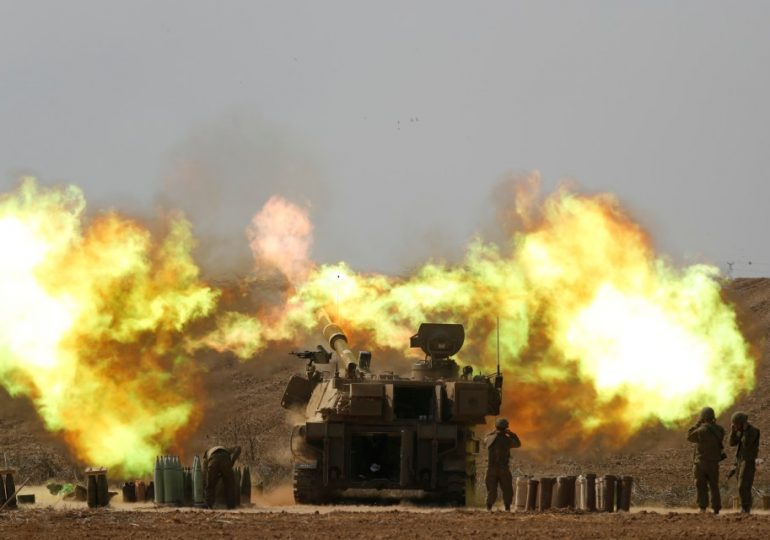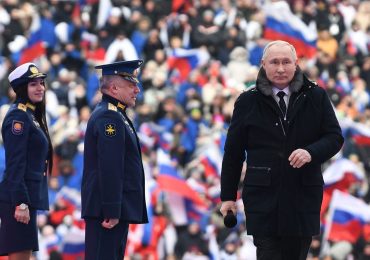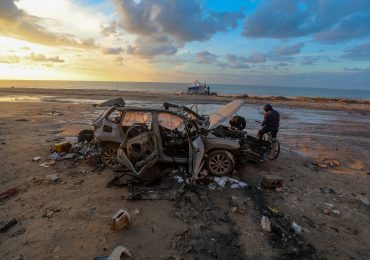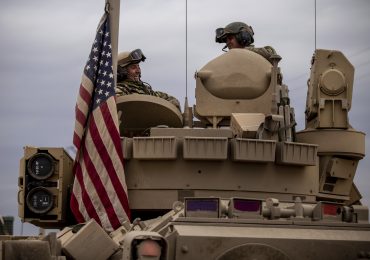IN THE six months since Hamas attacked Israel, hotbeds of simmering tension across the Middle East have exploded into bloody conflict.
Now military analysts have warned of a “gathering storm” and the threat of WW3, explaining what could happen next inside Gaza.
EPAIsraeli troops have been fighting in Gaza for months[/caption]
Dan CharityThe IDF have been preparing for if the war expands beyond the Strip[/caption]
The Gaza Strip has been destroyed after six months of war between Hamas and Israel
On October 7, 2023, Hamas terrorists stormed the border between Gaza and Israel, slaughtering over 1,200 Israelis and kidnapping hundreds more.
In the months since, Israel has almost completely destroyed the strip in an effort to eradicate the group and bring home its trapped people.
Amid international cries for peace, Israeli PM Netanyahu has vowed not to stop until Hamas is destroyed.
Military analysts spoke to The Sun about rising global criticism surrounding Israel’s methods and why the tragic deaths of six aid workers this week might be the catalyst for a ceasefire after months of bloodshed.
Retired General Richard Barrons told The Sun the Middle East is stuck in a “very difficult grey zone” as Israel fights an unwinnable war against Hamas.
Professor Anthony Glees dubbed it a “gathering storm” ahead of WW3 and Dr Anahita Motazed Rad warned that Iran threatens to tip the scales of a wider conflict via its vicious proxy groups.
And former British tank commander Colonel Hamish de-Bretton Gordon explained what could happen next in the “uncontrollable” melting pot of Middle East fighting.
They told The Sun that the risk of a wider conflict sits on the horizon and Israeli PM Netanyahu will likely have to go resign after the IDF killed seven people in an aid convoy in Gaza.
And experts explained that global fury after their deaths, including three Brits, could be the tipping point for long awaited ceasefire.
Israel’s revenge invasion
Operation Swords of Iron, the invasion into Gaza began with a blockade of resources to the enclave and an evacuation of the north.
It had two goals: to completely eradicate Hamas and bring the hostages home.
Israeli tanks approach the Strip ahead of the October invasion
A Palestinian baby injured after an Israeli attack carried into hospital for treatment in Rafah
The site of strikes between Hamas and Israel in Rafah, Gaza, during a hostage rescue operation
Over 100 still remain in the Strip and around 30 are thought to have been killed – possibly by IDF strikes.
Heavy airstrikes, the blocking of aid and the targeting of hospitals and refugee camps where the IDF says terrorists are hiding has left most of Gaza a smoking wasteland.
Israel has been the subject of enormous international scrutiny as the death toll of civilians in Gaza sits at an astonishing 250 per day.
We are at a very dark moment in our history and to talk about a gathering storm seems to me to be quite accurate
Prof Anthony Glees
The UN reports that over 30,000 Palestinians have been killed in six months including more children than in four years of worldwide conflict.
For those who are still alive and crammed into the borderland of Rafah in the south, malnutrition is rife and famine is a fast-approaching fear.
General Barrons explained that Netanyahu’s vow to completely destroy Hamas was never achievable to begin with.
He told The Sun: “Israel’s government is determined to eliminate Hamas… Israel has prioritised that over everything else.
“And it’s never, ever been achievable in military terms. You cannot eliminate an organisation by force because it’s an idea.
“Israel knows this perfectly well. It can inflict such a price on Gaza that Hamas is deterred and diminished but not destroyed.”
There are too many people sitting back on the sidelines, and all we’re seeing is thousands of civilians being injured and killed in Gaza
Col Hamish de-Bretton Gordon
Mr De Bretton Gordon added: “There are too many people sitting back on the sidelines, and all we’re seeing is thousands of civilians being injured and killed in Gaza.”
He said: “I don’t think the Israelis and certainly anybody else expected it to last quite so long, six months, most people thought it was going to be over in a few weeks.
“We’re in really dangerous times.”
And Professor Glees said: “I think it will take two generations for Israel to come to terms with what it’s done since Oct 7; over 30,000 Gazans killed, clear evidence of war crimes… IDF soldiers acting as if they’re on a ‘killing spree’.
“We are at a very dark moment in our history and to talk about a gathering storm seems to me to be quite accurate.”
He warned that the fractious climate is how world wars start.
“The history of both world wars in the last century shows that they do start with a gathering storm,” Professor Glees said.
“It’s a drip, drip, drip and that leads to a situation which cannot be managed and cannot be controlled any longer.”
A possible ceasefire in Gaza
When six aid workers and their Palestinian driver were killed by the IDF in a Gaza Strike, leaders around the world expressed fury at how Israel’s forces could’ve made such a “grave mistake”.
General Barrons dubbed it “unforgivable” as Israel admitted that mistaken intelligence led them to believe Hamas terrorists were hiding in the convoy.
The three Brit aid workers killed by the IDF in Gaza this week
Experts said Israeli PM Netanyahu may be forced to step aside
He told The Sun: “If you look at the global outrage… some of the UK’s finest legal minds are suggesting Israel has engaged in genocide.”
Mr De Bretton Gordon thinks their deaths could be “a turning point in the war”.
“The attacks on the aid workers this week might well bring about that ceasefire… bring everybody to a table where you know Hamas will release the hostages and they can come to some sort of agreement.”
He added: “Israeli politicians are making decisions that the Israeli military commanders should be making.
“I think a lot of military commanders have been forced to do things that ordinarily they would not do.
“Something has got to change.”
The attacks on the aid workers this week might well bring about that ceasefire
Col Hamish de-Bretton Gordon
Professor Glees said everyone from commanders to voters in Israel will be “anxious” about the country’s fate sitting in Netanyahu’s hands.
He explained that the PM’s time in power might be coming to an end as his approach to the war in Gaza loses him support – even from his biggest ally in the US.
He told The Sun: “If I were an Israeli, whether commander or just voter, I’d be anxious that the country’s fate is the hands of a man like this”.
Iran’s influence
Iran and Israel have been involved in their own cold war of sorts for years.
Tehran has backed and funded powerful groups like Hamas, Hezbollah and the Houthis – all enemies of Israel – for a long time.
Mr de-Bretton Gordon, Professor Glees and Dr Rad all told The Sun that Iran is the major power player behind the war we see unfolding in Gaza.
Mr de Bretton-Gordon said Iran is also the only player who can “change the game”, if it forces proxy Hamas to join mediation or accept ceasefire terms.
Iran really is the one who can change the game. I think they hold all the cards here, controlling Hamas
Col Hamish de-Bretton Gordon
“Iran really is the one who can change the game. I think they hold all the cards here, controlling Hamas,” he said.
Wreckage of Iran’s Syrian embassy after an Israeli strike killed a top Tehran commander
Iranian protesters burn an Israeli flag during an anti-Israel rally
“The real fight is between Iran and Israel. They are the sworn enemies.”
Dr Rad, who lectures in international relations at LSE, told The Sun that the two countries are caught in a ruthless chain of actions and reactions.
Seven Iranian officers including a top general were killed when suspected Israeli warplanes bombed their consulate in Syrian capital Damascus on Tuesday.
Iranian top brass Ebrahim Rasi vowed to seek revenge and said the attack would “not go unanswered” – a promise which Dr Rad said Iran will surely make good on.
And the endless cycle of violence between Israel and Iran, or its proxies, will doubtlessly lead to some kind of wider conflict.
“Tensions will rise in the region definitely,” she says, but it remains to be seen whether or not we will see a “full fledged war” in the Middle East.
Revenge on Israel for Tehran, she explains, could involve attacking Israeli bases, embassies or even civilians.
Houthi attacks in the Red Sea & allied airstrikes in Yemen
One of Iran’s long reaching proxy arms is the Houthi militant group, who have waged war against Israeli and Western vessels in the Red Sea.
Beginning on October 19, in response to the bombing of their allies Hamas in Israel, the Houthis launched their first missiles against a US Navy warship.
One of Iran’s terror proxies – the Houthis – who attacked US and UK ships in the Red Sea
The UK’s HMS Diamond shooting down drones launched by Houthi rebels in the Red Sea
In the months since they have targeted Israeli-flagged ships as well as those linked to its allies including the US and UK with drones and rockets.
Just weeks ago one of their attacks killed three people at sea.
The Israeli attack on the consulate in Damascus is a major escalation. Iran will respond. We’re in this very difficult grey zone
Gen Richard Barrons
The US and UK launched several joint operations in Yemen, bombing dozens of Houthi strongholds in and around the capital Sanaa.
Former General Richard Barrons told The Sun that the allied had obviously worked to deter Iran from spurring on its extremist group.
He said: “The Houthis appear to be doing less attacking on shipping. It’s clear that Iran told its proxies to dial it down.”
But despite this lull, he warned the attack on Iran’s embassy is another major escalation.
“The Israeli attack on the consulate in Damascus is a major escalation. Iran will respond. We’re in this very difficult grey zone.”
Russia and Iran
Russia has a long and friendly history with one of Israel’s biggest enemies and Hamas’ key backers – Iran.
Israel’s war with Hamas plays into Russia’s hands, taking global attention away somewhat from the frontline in Ukraine.
Putin, although not directly involved in what’s happening in the Middle East, is indirectly involved through its ally Iran, who is stoking all of this up
Col Hamish de-Bretton Gordon
And conflict between Russia’s ally Iran and the West offers the Kremlin a chance to disrupt democracies, challenging America’s position, for example, as a world power.
Mr de-Bretton Gordon told The Sun: “Putin, although not directly involved in what’s happening in the Middle East, is indirectly involved through its ally Iran, who is stoking all of this up.”
Israel’s war also hampers the Western aid packages being poured into Kyiv, as the financial implications of a fresh Middle East conflict are huge.
Mr de-Bretton Gordon told The Sun: “The Americans are still supplying the Israelis with weapons, but they’re not supplying the Ukrainians.
“The world is looking at, you know, the eastern Mediterranean. At the moment, they’re not looking at Europe.
“They’re not looking at Ukraine, as far as Putin’s going, the more petrol you can chuck onto the Middle East the better.”
Threat of World War 3
In the last six months, the world has watched fighting explode throughout the Middle East whilst also fearing war in Europe.
Experts have warned that the human race is at it’s “most dangerous moment” in history.
Meanwhile Iran pushes its nefarious agenda on the sidelines, Netanyahu refuses to answer International calls for peace, and civilians in Gaza continue to die in their hundreds daily.
All the while Putin’s alliance with Iran represents the alliance of Western-hating dictators who would jump on any opportunity to tackle democracies like the US and UK.
Chances of the Middle East crisis developing into a full-scale war are at an all-time high.
Leave a comment








